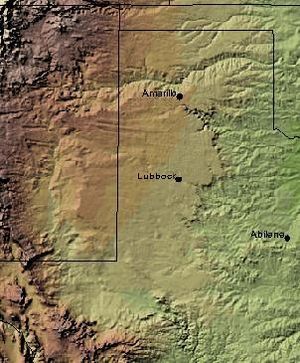Geology of Texas

General geology
North and west of the faults are the Stockton,
Almost in the center of these Cretaceous rocks is the Llano Uplift, a geologic dome of Precambrian gneiss, schist, and granite, surrounded by Paleozoic sedimentary rocks. The granite here is quarried for construction, but it is perhaps best known to Texans through its manifestation as Enchanted Rock.
From
The geology of west Texas is arguably the state's most complex, with a mix of exposed Cretaceous and Pennsylvanian strata, overlain by Quaternary conglomerates. A series of faults trend southeast to northwest across the region, from Big Bend to El Paso; there are also extensive volcanic deposits. The Marathon Mountains northeast of Big Bend National Park have long been of special interest to geologists; they are the folded and eroded remains of an ancient mountain range, created in the same orogeny that formed the Ouachita and Appalachian Mountains.[2]
Historical geology

The Precambrian metamorphic and igneous rocks of the Llano Uplift probably formed during the Mesoproterozoic Grenville orogeny, which was part of the assembly of the supercontinent Rodinia. Over time, the mountains of the Grenville orogeny were eroded flat, and later covered by Paleozoic and Mesozoic sediments that were not uplifted and eroded in their present manner until the late Cenozoic.
Early to middle
Early and middle Mesozoic strata are, on the whole, poorly represented in Texas. Triassic rocks are limited to sandstone and shale in the Panhandle, while the Jurassic record is almost nonexistent at the surface.[7] During the Late Triassic and Jurassic, the Gulf of Mexico was formed from a rift southeast of the Ouachita Mountains.[8] Deeply buried salt deposits and marine limestones under the coastal plain also date from the Jurassic, when the first shallow seas formed.[7]
The late Mesozoic record is much richer. Cretaceous rocks—particularly those of the Lower Cretaceous—are widespread at the surface, with yet more buried under the coastal plain. The strata consist of massive limestone sequences deposited when the entire region was submerged under the Western Interior Seaway, during the last great marine transgression.[9]
The Western Interior Seaway had withdrawn by the beginning of the Cenozoic, the era that put the finishing touch on Texas's current geology. The modern coastal plain formed during this time; it comprises increasingly thick sediments (perhaps 15 km deep at the coastline) deposited southeastward into the downwarping Gulf of Mexico.[10]
West Texas was rent by volcanism during the Eocene and Oligocene epochs, activity which formed most of the modern topography of the area.[1] Later crustal extension created a series of alternating horsts and grabens similar to those in the Basin and Range Province of the western U.S. A late Cenozoic uplift of the Rocky Mountains led to the deposition of a vast fan of eroded sediment to their east, forming the Ogallala Formation that covers much of the Panhandle. Most of the state's current stream valleys and canyons date from the Pleistocene to the present, as the final geologic shaping of the state.[10]
Economic geology
Texas has been the leading state in
The state also produces nonfuel minerals such as uranium; much of its nonfuel mineral value is derived from production of cement, crushed stone, industrial sand, and construction sand and gravel.[15][16] In the past, the state mined mercury, silver, and copper.[17][18][19]
See also
- Mount Blanco
- Mount Bonnell
- Llano Estacado
- Palo Duro Canyon
- Caprock Canyons
- Red Beds of Texas and Oklahoma
- Geology of Wichita Falls, Texas
- Geology of the United States
- Geology of North America
- Extreme point of Texas
- List of fossiliferous stratigraphic units in Texas
External links
Footnotes
- ^ a b c "TSHA | Geology". www.tshaonline.org. Retrieved 2021-03-06.
- ^ USGS Archived 2006-02-17 at the Wayback Machine
- ISBN 978-0-87842-265-4pp. 4–7
- ^ Spearing, p. 7
- ^ "The Permian Reef Complex (Delaware Basin) of West Texas-slide 1". Eos.ubc.ca. Archived from the original on 2015-09-24. Retrieved 2016-02-25.
- ^ "Global Stratotype Sections and Points". Archived from the original on April 23, 2006. Retrieved April 30, 2006.
- ^ a b Spearing, p. 8
- ISSN 0149-1423.
- ^ Spearing, p. 9
- ^ a b Spearing, pp. 10–11
- ^ "TSHA | Spindletop Oilfield". www.tshaonline.org. Retrieved 2021-03-06.
- ^ "The Texas Miracle: Only five countries now produce more oil than The Lone Star State - AEI". AEI. Retrieved 2018-02-22.
- ISSN 0301-4215.
- ^ "Regulators crack down on Texas shale gas flaring". www.worldoil.com. 10 February 2021. Retrieved 2021-04-06.
- ^ "Nonpetroleum Minerals | Texas Almanac". texasalmanac.com. 2020-06-25. Retrieved 2021-04-06.
- ISSN 2524-3470.
- ^ "TSHA | Mercury Mining". www.tshaonline.org. Retrieved 2021-04-06.
- ^ "TSHA | Silver Mining". www.tshaonline.org. Retrieved 2021-04-06.
- ^ "TSHA | Copper Production". www.tshaonline.org. Retrieved 2021-04-06.
References
- American Association of Petroleum Geologists. "Geological Highway Map of Texas." Tulsa, 1979.
- Geologic Provinces of the United States: Ouachita-Ozark Interior Highlands (Accessed 3/27/06)
- Spearing, Darwin. Roadside Geology of Texas. Missoula: Mountain Press Publishing Company, 1991. ISBN 978-0-87842-265-4
